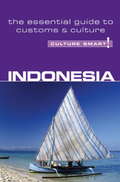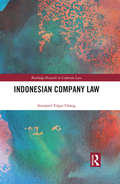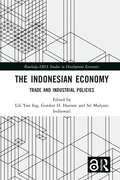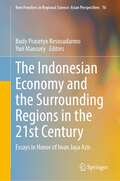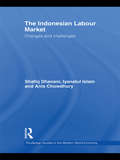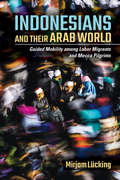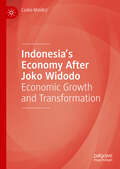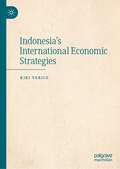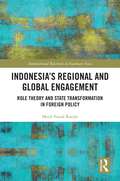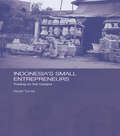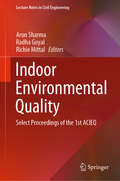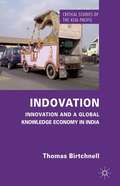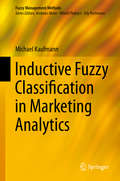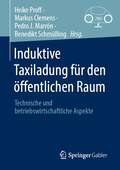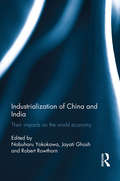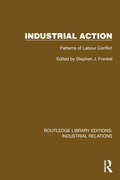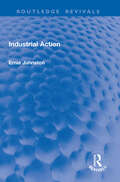- Table View
- List View
Indonesia - Culture Smart!
by Graham SaundersCulture Smart! provides essential information on attitudes, beliefs and behavior in different countries, ensuring that you arrive at your destination aware of basic manners, common courtesies, and sensitive issues. These concise guides tell you what to expect, how to behave, and how to establish a rapport with your hosts. This inside knowledge will enable you to steer clear of embarrassing gaffes and mistakes, feel confident in unfamiliar situations, and develop trust, friendships, and successful business relationships. Culture Smart! offers illuminating insights into the culture and society of a particular country. It will help you to turn your visit-whether on business or for pleasure-into a memorable and enriching experience. Contents include * customs, values, and traditions* historical, religious, and political background* life at home* leisure, social, and cultural life* eating and drinking* do's, don'ts, and taboos* business practices* communication, spoken and unspoken "Culture Smart has come to the rescue of hapless travellers." Sunday Times Travel "... the perfect introduction to the weird, wonderful and downright odd quirks and customs of various countries." Global Travel "...full of fascinating-as well as common-sense-tips to help you avoid embarrassing faux pas." Observer "...as useful as they are entertaining." Easyjet Magazine "...offer glimpses into the psyche of a faraway world." New York Times
Indonesian Company Law (Routledge Research in Corporate Law)
by Soonpeel Edgar ChangIn modern countries, a company is commonly categorized as either public or privately-held, depending on whether securities are publicly traded on the open market, into a government-owned company or private company depending on government ownership, or a financial company or non-financial company depending on its main business, and so on. Of course, these categories are generally used in Indonesia as well. A unique aspect in Indonesia is that a well-settled legal practice mainly uses a dichotomy of company types that is rarely popular in foreign countries: a company with foreign direct investment (penanaman modal asing, or PMA) or company with 100% domestic direct investment (penanaman modal dalam negeri, or PMDN). Government plans concerning how to differently regulate these companies frequently becomes a national issue, as it is one of the main standards to evaluate how effectively and willingly the Indonesian government develops its economic policies. Laws, regulations, and actual legal practice also treat the two types of companies differently, based on whether a company has a foreign shareholder. Although many foreign countries are also equipped with similar regulations over companies with foreign direct investment, Indonesia distinctively applies this dichotomy for much wider uses for several reasons. This book is designed to assist students, practitioners, and researchers with clear and comprehensive treatment of key concepts in Indonesian company law. Significant business, economic, and policy issues are highlighted together with a thorough analysis of the important statutory provisions and cases used in the study of Indonesian company law. The book includes the major theoretical approaches used in current company law literature and statutory issues are covered under both the 2007 Indonesian Company Act and the 2007 Indonesian Capital Investment Act. The book will be an essential reference for investors and businesses contemplating entering the Indonesian Market.
The Indonesian Economy: Trade and Industrial Policies (Routledge-ERIA Studies in Development Economics)
by Gordon H. Hanson Lili Yan Ing Sri Mulyani IndrawatiAgainst the backdrop of growing anti-globalisation sentiments and increasing fragmentation of the production process across countries, this book addresses how the Indonesian economy should respond and how Indonesia should shape its trade and industrial policies in this new world trade environment. The book introduces evaluation not on tariffs but on new trade instruments such as non-tariff measures (SPS, TBT, export measures and beyond border measures), and looks at industrial policies from a broader perspective such as investment, accessing inputs, labour, services, research and innovation policies.
The Indonesian Economy and the Surrounding Regions in the 21st Century: Essays in Honor of Iwan Jaya Azis (New Frontiers in Regional Science: Asian Perspectives #76)
by Budy Prasetyo Resosudarmo Yuri MansuryThis book broadens the reader’s knowledge of several important issues having to do with the economy of Indonesia and its surrounding regions, to which Professor Iwan Jaya Azis has made significant contributions in the last 40 years. The book is divided into three parts, the first of which contains several chapters describing fundamental methods in regional economics, development economics, macroeconomics, and finance. These methods are crucial in understanding the political economy of Indonesia and the neighboring regions. Among the techniques discussed are social accounting matrix (SAM) analysis, computable general equilibrium (CGE) modeling, and agent-based modeling (ABM) approaches. The second part is on several important issues related to the Indonesian economy. The topics covered are urbanization, resource booms, manufacturing, and micro and small enterprises. The book’s third part deals with the economies of several countries in the neighboring Southeast Asian region, including the Philippines, Vietnam, and Thailand.
The Indonesian Labour Market: Changes and challenges (Routledge Studies in the Modern World Economy)
by Shafiq Dhanani Iyanatul Islam Anis ChowdhuryThe topics of unemployment, underemployment, wage trends and patterns, and the relationship between poverty and the labour market are of interest to all policy makers, researchers, academics and journalists concerned with economic development. This book traces the evolution of the Indonesian labour market between the early 1970s and late 2000s. This entails a (a) review of macroeconomic policies and their employment impact; (b) review of unemployment and underemployment trends; (c) review of wage trends and living standards; (d) relationship between poverty, inequality and the labour market; and (e) labour market regulations, employment and the business environment. The book comes up with a number of policy-relevant findings. Macroeconomic policies, particularly inflation targeting in the 2000-2007 period, have not been conducive to employment generation. The assumption that unemployment is an appropriate indicator of labour market performance and, more importantly, that it is closely aligned with poverty, is shown to be inaccurate. Sustained real wage growth in the twenty-year period before the 1997 financial crisis is contrasted with the lack of improvement since then, a period otherwise of respectable economic growth by international standards. The predicted adverse consequences of sweeping labour market regulations in 2000-2007 on properly measured employment, unemployment and labour costs did not materialize, mainly because of low compliance. It seems that a restrictive macroeconomic framework has been more constraining for employment growth than the perceived labour market rigidity during the post-crisis period. The book concludes with an evaluation of several ‘reactive’ and ‘proactive’ labour market policies. Though these are complementary, policy makers in Indonesia have probably put too much emphasis on reactive policies such minimum wage and severance pay, and not enough on proactive policies aimed at creating an adaptable and skilled workforce.
Indonesians and Their Arab World: Guided Mobility among Labor Migrants and Mecca Pilgrims
by Mirjam LückingIndonesians and Their Arab World explores the ways contemporary Indonesians understand their relationship to the Arab world. Despite being home to the largest Muslim population in the world, Indonesia exists on the periphery of an Islamic world centered around the Arabian Peninsula. Mirjam Lücking approaches the problem of interpreting the current conservative turn in Indonesian Islam by considering the ways personal relationships, public discourse, and matters of religious self-understanding guide two groups of Indonesians who actually travel to the Arabian Peninsula—labor migrants and Mecca pilgrims—in becoming physically mobile and making their mobility meaningful. This concept, which Lücking calls "guided mobility," reveals that changes in Indonesian Islamic traditions are grounded in domestic social constellations and calls claims of outward Arab influence in Indonesia into question. With three levels of comparison (urban and rural areas, Madura and Central Java, and migrants and pilgrims), this ethnographic case study foregrounds how different regional and socioeconomic contexts determine Indonesians' various engagements with the Arab world.
Indonesia's Changing Political Economy
by Jamie S. DavidsonIndonesia is Southeast Asia's largest economy and freest democracy yet vested interests and local politics serve as formidable obstacles to infrastructure reform. In this critical analysis of the politics inhibiting infrastructure investment, Jamie S. Davidson utilizes evidence from his research, press reports and rarely used consultancy studies to challenge mainstream explanations for low investment rates and the sluggish adoption of liberalizing reforms. He argues that obstacles have less to do with weak formal institutions and low fiscal capacities of the state than with entrenched, rent-seeking interests, misaligned central-local government relations, and state-society struggles over land. Using a political-sociological approach, Davidson demonstrates that 'getting the politics right' matters as much as getting the prices right or putting the proper institutional safeguards in place for infrastructure development. This innovative account and its conclusions will be of interest to students and scholars of Southeast Asia and policymakers of infrastructure investment and economic growth.
Indonesia’s Economy After Joko Widodo: Economic Growth and Transformation
by Csaba MoldiczThis book examines the transformation of the Indonesian economy during the presidency of Joko Widodo and the economic policies that have underpinned it, with a particular focus on manufacturing, services and infrastructure development. It not only assesses the current social and economic conditions within Indonesia, but also explores Indonesia's place within the global economy and the important role it will play in the future, particularly with regard to global supply chains. The need to balance technological modernization and capital investment with economic and strategic autonomy is also discussed. This book outlines Indonesia's economic development in recent years and considers the country's potential for further development in the coming years. It will be relevant to researchers and policymakers interested in development economics and economic policy.
Indonesia's International Economic Strategies
by Kiki VericoThis book discusses Indonesia's international economic strategies. It examines unilateral aspects, foreign direct investments, bilateral economic relations, regional elements, ASEAN's role, and the Indo-Pacific's dynamic frameworks. Starting at the unilateral level, the book outlines how Indonesia managed its macro-economy to recover quickly and adequately from 2020 to 2021 amidst the global COVID-19 pandemic. It argues that Indonesia needs an open economic principle to enhance trade and investment relations. In addition, the book elaborates on how Indonesia transforms its economy with export-oriented long-run investment (Foreign Direct Investment) inflows as a necessary condition for economic transformation as it fits with Indonesia's manufacturing sector, which is critical to the country. Further, the book thoroughly explains Indonesia's bilateral economic relations, from its production networks with Indonesia's major partners to their impacts. It highlights the products which will provide enormous potential benefits for the country. The book also covers regional and mega-regional aspects of Indonesia's economy. Focusing on the Association of Southeast Asian Nations (ASEAN), it emphasises the regional organisation's three essential principles for economic integration: openness, convergence, and inclusiveness. In doing so, research in the book also includes perspectives on how ASEAN sees Asia and the Indo-Pacific framework. It also argues that ASEAN needs centrality in enlarging its economic cooperation with other countries or regions and how a member state's unilateral and bilateral liberalisation are building blocks for ASEAN.
Indonesia's OJK: Building Financial Stability
by David Lane Lakshmi IyerIn 2013, a new financial services authority, the Otoritas Jasa Keuangan (OJK), took over responsibility for regulating capital markets and non-bank financial institutions in Indonesia. OJK was scheduled to take over bank regulation and supervision from the central bank, Bank Indonesia, in 2014. At a time when there was no global consensus on the optimality of separating monetary policy from bank supervision, the creation of the OJK raised many questions. Would the OJK better prepare Indonesia to deal with financial crises? Could an organization whose leaders came from Indonesia's existing economic bureaucracies remain independent of those organizations and from political pressures? Was the creation of the OJK the correct response to public dissatisfaction with Bank Indonesia's handling of the Asian financial crisis and subsequent corruption scandals?
Indonesia’s Regional and Global Engagement: Role Theory and State Transformation in Foreign Policy (International Relations in Southeast Asia)
by Moch Faisal KarimKarim examines the changes and continuity of Indonesia’s foreign policy in the post-authoritarian era, under presidents Susilo Bambang Yudhoyono and Joko Widodo. Indonesia conceptualised and aimed to adopt four principle roles after 2004 – being a voice for developing countries; being a regional leader; being an advocate for democratic and human rights; and being a bridge-builder. These roles, however, were by no means stable and were constantly being negotiated and contested. Karim analyses the contested nature of Indonesian foreign policy and the limits this places on consistency in enacting these roles. He highlights two drivers for such limitations – conflicting role conceptions and state fragmentation. He develops this argument based on four case studies of Indonesia’s engagement in human rights governance and trade governance at both regional and global levels. Essential reading for students and scholars of Indonesia’s foreign policy, that will also be of substantial value to those studying policy in Southeast Asia more broadly.
Indonesia's Small Entrepreneurs: Trading on the Margins
by Sarah TurnerIn the context of Makassar, on the eastern Indonesian island of Sulawesi, the book explores the socioeconomic and cultural relationships that make life for small entrepreneurs in Makassar so distinctive. Using a new framework for the study of small enterprises - the 'small enterprise integrative framework' - this book gives us a greater understanding of the organization and operations of small enterprises in developing countries, at both the micro and macro levels. The application of this new framework for research reveals the diversity of labour flexibility, networking and cluster styles amongst the enterprises studies, and the constraints they face for growth. Whilst the recent Southeast Asian economic crisis has been heralded by certain commentators as a new era for small enterprises in the region, the book concludes that local realities for the small enterprises in Makassar mean that, whilst for some it has been a time of shifting fortunes, others have continued trading on the margins.
An Indoor Air Quality Management Framework for Municipal Buildings in Developing Economies (Routledge Research Collections for Construction in Developing Countries)
by Mpho Ndou Clinton Ohis Aigbavboa Wellington Didibhuku Thwala Abdul-Majeed MahamaduThis book delves into the pivotal issue of Indoor Air Quality (IAQ) management in municipal buildings within developing economies, addressing a pressing need in today’s digital age, where individuals spend over 70% of their time indoors. With a strong focus on enhancing environmental quality, this book presents theoretical frameworks and practical recommendations designed explicitly for stakeholders in the higher education sector, encompassing both public and private institutions.As institutions strive to improve their learning environments, this book aligns with global Sustainable Development Goals (SDGs), highlighting the vital connection between effective IAQ management and the health and well-being of the institutional community, including students and staff members. It provides a comprehensive framework that advocates for improved IAQ management and emphasises the importance of quality education and lifelong learning.Furthermore, this book serves as a valuable resource for green building regulatory bodies, ensuring adherence to best practices in IAQ management within municipal buildings. By providing actionable strategies grounded on recent literature, the book is an essential guide for researchers and policymakers seeking to navigate the theoretical and empirical dimensions of IAQ management. Moreover, this book asserts that enhancing IAQ is necessary not only for regulatory compliance and community well-being but also as a vital investment in the academic and operational success of municipal buildings in developing economies.
Indoor Environmental Quality: Select Proceedings of the 1st ACIEQ (Lecture Notes in Civil Engineering #60)
by Arun Sharma Radha Goyal Richie MittalThis volume presents selected papers presented during the First Asian Conference on Indoor Environmental Quality (ACIEQ). The contents cover themes of indoor air quality monitoring and modeling; the influence of confounding factors like thermal comfort parameters, such as temperature and relative humidity with respect to different building types, e.g., residential, commercial, institutional; ventilation characteristics, lighting and acoustics. It also focuses on people's performance, productivity, and behavior with respect to their exposure to various indoor air pollutants and parameters influencing the overall indoor environmental quality. This volume is primarily aimed at researchers working in environmental science and engineering, building architecture and design, HVAC and ventilation, public health, and epidemiology. The contents of this volume will also be useful to policy makers working on occupational health and building codes.
Indovation
by Thomas BirtchnellHow should we understand the many reports that poverty is the mother of innovation in India? What has the role of austerity been in the development of India's knowledge economy? In this critical study of Indian innovation, or 'Indovation', Thomas Birtchnell explores how the complex mobilities of 'globals' with stakes in India have transformed discourses and imaginaries about innovation in the region. He adopts a critical eye to the notion of Indovation by focusing on the various circuits of globals where India's knowledge economy is concentrated: expertise, entrepreneurship and community. Birtchnell traces the various discourses and counter-discourses around an Indian way of working and illustrates how differences in the international dimensions of austerity allow India's knowledge economy to prosper.
Inductive Fuzzy Classification in Marketing Analytics
by Michael KaufmannTo enhance marketing analytics, approximate and inductive reasoning can be applied to handle uncertainty in individual marketing models. This book demonstrates the use of fuzzy logic for classification and segmentation in marketing campaigns. Based on practical experience as a data analyst and on theoretical studies as a researcher, the author explains fuzzy classification, inductive logic and the concept of likelihood and introduces a blend of Bayesian and Fuzzy Set approaches, allowing reasonings on fuzzy sets that are derived by inductive logic. By application of this theory, the book guides the reader towards a gradual segmentation of customers which can enhance return on targeted marketing campaigns. The algorithms presented can be used for visualization, selection and prediction. The book shows how fuzzy logic can complement customer analytics by introducing fuzzy target groups. This book is for researchers, analytics professionals, data miners and students interested in fuzzy classification for marketing analytics.
Induktive Taxiladung für den öffentlichen Raum: Technische und betriebswirtschaftliche Aspekte
by Heike Proff Markus Clemens Pedro J. Marrón Benedikt SchmüllingDer Markthochlauf der Elektromobilität wird bislang durch die fehlende Ladeinfrastruktur für einzelne Anwendungen erschwert. Gerade in der Taxibranche sind Elektrofahrzeuge unterrepräsentiert, weil durch das an Taxiwarteständen geltende Vorrückprinzip bisherige (kabelgebundene) Ladekonzepte nicht umsetzbar sind.Mit der Technologie des induktiven Ladens lassen sich die Potenziale von Elektrofahrzeugen im Taxisegment nutzen: die Wartezeiten können als Ladezeit genutzt werden und Elektrotaxis tragen zur Verbesserung der Luft in Innenstädten bei.Das Buch fasst Ergebnisse des Forschungsprojektes TALAKO (Taxiladekonzept für Elektrotaxis im öffentlichen Raum) zusammen, in dem eine induktive Pilotanlage entwickelt sowie in Köln aufgebaut und getestet wurde.
Indus Towers: From Infancy to Maturity
by Ranjay Gulati Maxim Sytch Rachna TahilyaniIndus Towers, the world's largest telecom tower company, is a joint venture between three telecom rivals in India. These rivals-Bharti Airtel, Vodafone India, and Idea Cellular-combined their telecom towers to provide "shared telecom infrastructure" to wireless telecom operators on a nondiscriminatory basis. The CEO has transformed Indus from a struggling startup with a monopolistic mindset into a customer-centric organization. He now wants to grow Indus. To achieve this, however, he needs to reconcile conflicting objectives among Indus's shareholders. All three shareholders are also his customers; often these dual roles engender different perspectives and lead to different requirements. The CEO needs to determine how to convince the board to take a decision that keeps Indus's best interests in mind while balancing the operators' interests.
Indus Towers: Collaborating with Competitors on Infrastructure
by Ranjay Gulati Rachna Tahilyani F. Asis Martinez-Jerez V. G. NarayananThe case describes the formation of Indus Towers, the largest telecom tower company in the world which has a joint venture created to build and manage the passive infrastructure of wireless telecom operators by bringing together three competitors in India's tough telecom market-Bharti AirteI, Vodafone Essar, and Idea Cellular-and merging their tower holdings. It focuses on the issue as to how do you collaborate with your competitors in setting up towers but engage in a brutal competition with them in the market place?
Indus Towers: From Infancy to Maturity
by Maxim Sytch Rachna Tahilyani Ranjay GulatiIndus Towers, the world's largest telecom tower company, is a joint venture between three telecom rivals in India. These rivals-Bharti Airtel, Vodafone India, and Idea Cellular-combined their telecom towers to provide "shared telecom infrastructure" to wireless telecom operators on a nondiscriminatory basis. The CEO has transformed Indus from a struggling startup with a monopolistic mindset into a customer-centric organization. He now wants to grow Indus. To achieve this, however, he needs to reconcile conflicting objectives among Indus's shareholders. All three shareholders are also his customers; often these dual roles engender different perspectives and lead to different requirements. The CEO needs to determine how to convince the board to take a decision that keeps Indus's best interests in mind while balancing the operators' interests.
Industralization of China and India: Their Impacts on the World Economy
by Robert Rowthorn Jayati Ghosh Nobuharu YokokawaThis book provides new perspectives on recent Asian dynamism which go beyond the mainstream views, by attempting to situate the recent economic expansion within a broader analysis of capitalist accumulation and the various processes that it generates both within and across economies. The contributions in the book include analyses of recent growth patterns in both China and India; assessments of the sustainability of such growth and potential constraints and pitfalls; the role of international finance in affecting both national and international growth and employment patterns; the factors determining particular accumulation strategies and the results of these strategies. These forces within the two economies of China and India are situated within a broader assessment of the impacts on the world economy, by identifying long run tendencies in international capitalism and changing patterns of uneven development. Specific issues emerging within the Asian region are identified, including not just the relations between the three large Asian economies, but also the wider geopolitical implications as well as the political economy of these changes. This book therefore provides a more comprehensive examination of the longer run dynamics of the global capitalist system in which these economies are necessarily destined to play more significant roles in future.
Industrial Action: Patterns of Labour Conflict (Routledge Library Editions: Industrial Relations)
by Stephen J. FrenkelIndustrial Action (1980) examines in a comparative analysis the principal elements involved in industrial action – strikes, work-to-rule, go-slows etc – in four key industries in Australia – construction, shipbuilding, the waterfront and telecommunications. The individual case studies are placed within a theoretical and an international perspective, and conclusions are drawn which point up many common threads running through industrial relations in widely differing industries.
Industrial Action (Routledge Revivals)
by null Ernie JohnstonIndustrial Action (1976), written by an experienced active trade unionist, brings valuable real-world examples to an examination of the many facets of trade union organising. It looks at the organising of the workforce, recruitment of new members, worker–management dialogue, strike action, picketing and conflict resolution.
